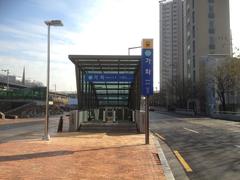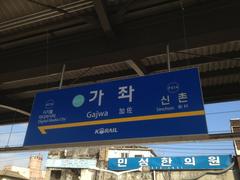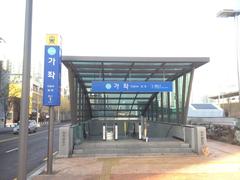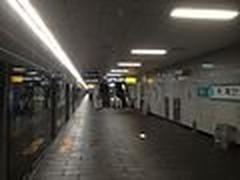
Gajwa Station: Visiting Hours, Tickets, and Nearby Historical Sites in Seoul
Date: 14/06/2025
Introduction: Gajwa Station’s Role in Modern Seoul
Gajwa Station, located in the heart of Mapo-gu, Seoul, is a testament to the city’s ongoing transformation—bridging its past as a rural outpost with its current status as a lively urban transport hub. Originally constructed in the early 20th century as a minor stop on the Gyeongui Line, Gajwa Station played a modest role in supporting agricultural trade and local passenger movement. As Seoul experienced rapid growth, particularly during the economic surge known as the “Miracle on the Han River,” Gajwa evolved to meet the needs of a sprawling metropolis. Today, it is an integral node on the Gyeongui–Jungang Line, seamlessly connecting commuters and travelers to vibrant districts like Hongdae, Sinchon, and Ewha Womans University, as well as major transit centers such as Seoul Station.
This guide provides a detailed overview of Gajwa Station’s historical evolution, practical information for visitors—including visiting hours and ticketing—its significance in Seoul’s transportation network, and tips for exploring cultural sites nearby. Whether you are a first-time visitor or a seasoned commuter, you’ll find essential insights to enhance your experience in one of Seoul’s most dynamic neighborhoods (Seoul city history, Gyeongui–Jungang Line Wikipedia, Korea Travel Planning).
Table of Contents
- Historical Evolution of Gajwa Station
- Visitor Information: Hours, Tickets, and Tips
- Significance in Seoul’s Transit Network
- Visitor Experience and Practical Tips
- Nearby Historical and Cultural Sites
- Frequently Asked Questions
- Conclusion
- References and Useful Links
Historical Evolution of Gajwa Station
From Rural Outpost to Urban Connector
Gajwa Station opened as a minor stop along the Gyeongui Line in the early 1900s, supporting Seoul’s then-rural outskirts. The station’s significance grew during the Japanese colonial era, when the broader rail network was expanded for administrative and industrial purposes (Seoul city history). After Korea’s liberation in 1945, waves of urbanization and population growth led to the westward expansion of Seoul, gradually integrating Gajwa into the city’s urban core.
Subway Integration and Modernization
A turning point came with the integration of the Gyeongui Line into the Seoul Metropolitan Subway system. With the launch of commuter rail services in 2009, Gajwa Station underwent major upgrades: expanded platforms, barrier-free accessibility, digital information displays, and the adoption of contactless fare systems. The subsequent merger into the Gyeongui–Jungang Line further enhanced connectivity, making Gajwa a pivotal interchange for commuters traveling across the greater metropolitan area (Gyeongui–Jungang Line Wikipedia).
Urban Renewal and Digital Transformation
The neighborhoods surrounding Gajwa Station have been revitalized through urban renewal projects, replacing older buildings with modern apartments, retail centers, and improved public amenities. Investment in digitalization—such as real-time train information, public Wi-Fi, and automated lockers—has made the station more accessible and convenient for both locals and visitors (Korea Travel Planning, Unravel Korea).
Visitor Information: Hours, Tickets, and Tips
Operating Hours
- Station Hours: Approximately 5:30 AM to midnight daily
- Ticket Office: Usually 6:00 AM–10:00 PM (may vary on holidays)
Ticketing and Payment
- Tmoney Card: Rechargeable smart card for subway, bus, and some taxis; available at convenience stores and station kiosks
- RailPlus Card: Usable across multiple transit networks
- Single Journey Tickets: Purchase at automated machines near the platforms
- Korail Pass: Special multi-use pass for tourists, valid on intercity and commuter rails
Fares start at 1,350 KRW for short journeys, with incremental increases for longer distances.
Tip: Always tap your card at both entry and exit gates to ensure the correct fare is deducted. Discounted fares are available for children, seniors, and passengers with disabilities.
Accessibility
Gajwa Station is fully accessible, offering elevators, ramps, tactile paving for the visually impaired, and accessible restrooms.
Significance in Seoul’s Transit Network
Gajwa Station’s location on the Gyeongui–Jungang Line positions it as a crucial connector between local neighborhoods and the wider city. It offers direct access to Seoul Station—linking travelers to KTX high-speed trains, AREX airport rail, and multiple subway lines (Unravel Korea). This enables rapid transit to destinations like Busan, Jeonju, and Incheon International Airport.
The station also serves as a key transfer point for those heading to Hongdae’s youthful hub, Sinchon’s lively student scene, and Ewha Womans University. By supporting multimodal travel, Gajwa reduces car dependency, eases congestion, and advances Seoul’s sustainability goals (The Soul of Seoul).
Visitor Experience and Practical Tips
Navigating the Station
- Signage: Clear, bilingual (Korean/English) signs throughout the station
- Lockers: Coin-operated and card-payment lockers for short-term luggage storage
- Amenities: Restrooms, public Wi-Fi, and recharge stations for Tmoney cards
- Digital Resources: Use KakaoMap or Naver Map for real-time navigation and transit updates (Korea Travel Planning)
Accessibility: Elevators and barrier-free routes ensure easy movement for all travelers.
Safety and Etiquette
- Security: CCTV monitoring and station staff present
- Etiquette: Eating/drinking is prohibited on trains; offer priority seating to those in need
- Rush Hours: Avoid peak times (7:30–9:00 AM, 6:00–7:30 PM) for a more comfortable journey
- Language: Staff assistance is available; translation apps like Papago are helpful (Hey Roseanne)
Nearby Historical and Cultural Sites
While Gajwa Station is not itself a historical landmark, its connectivity makes it an excellent base for exploring Seoul’s heritage and culture.
Local Highlights
- Hongdae (Hongik University Area): Live music, art, cafes, street performances
- Mangwon Market: Traditional market with street food and local goods (Korea Trip Guide)
- Yeonnam-dong: Hip neighborhood with boutiques and galleries
- Sandnae Market: Authentic Korean food and produce
- World Cup Park: Expansive green space with themed gardens
Easy Transfers to Major Historical Sites
- Gyeongbokgung Palace: Iconic royal palace easily reached by transferring to Line 3 (Official Gyeongbokgung Palace Website)
- Bukchon Hanok Village: Traditional houses and cultural experiences
- Insadong: Art galleries, tea houses, and antiques
Frequently Asked Questions
Q: What are Gajwa Station’s operating hours?
A: Approximately 5:30 AM to midnight; ticket counters typically 6:00 AM–10:00 PM.
Q: How do I buy tickets at Gajwa Station?
A: Use Tmoney or RailPlus cards, or purchase single journey tickets at automated machines.
Q: Is Gajwa Station accessible for people with disabilities?
A: Yes, with elevators, tactile paving, and accessible restrooms.
Q: Are there lockers for luggage storage?
A: Yes, coin and card-operated lockers are available.
Q: What attractions are near Gajwa Station?
A: Hongdae, Mangwon Market, Sandnae Market, World Cup Park, and easy transfer options to Gyeongbokgung Palace and Bukchon Hanok Village.
Conclusion
Gajwa Station embodies the dynamic synthesis of Seoul’s tradition and modernity. From its humble beginnings to its current status as a vital interchange, the station supports both daily commuters and curious travelers, offering efficient transit, accessible facilities, and a gateway to vibrant neighborhoods and historical sites. Whether you seek the urban pulse of Hongdae, the authenticity of Mangwon Market, or the grandeur of Gyeongbokgung Palace, Gajwa Station makes exploration effortless. Use digital resources like KakaoMap and travel apps such as Audiala for the latest updates and seamless navigation. Plan your visit and discover the multifaceted character of Seoul through the lens of Gajwa Station (Unravel Korea, Korea Travel Planning, The Soul of Seoul).
References and Useful Links
- Seoul city history
- Gyeongui–Jungang Line Wikipedia
- Korea Travel Planning
- Unravel Korea
- The Soul of Seoul
- Hey Roseanne
- Korea Trip Guide
- Official Gyeongbokgung Palace Website
- Visit Seoul official site
- Seoul Tourist Map
















































































































































































































